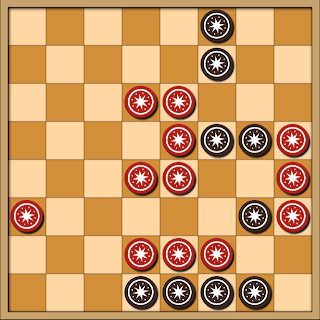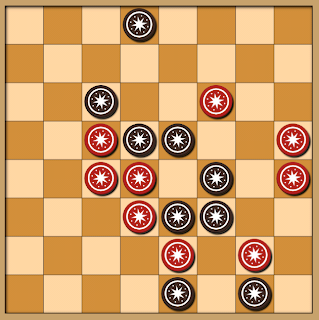Game 8 - Me vs hyxxy - 10/19/13 on iggamecenter.com
Lots of commentary on this one.1.c8-c6 a2-c2
2. b1-b3
This has become a standard opening for me.
…h4-f2
3. f1xh3
This move gives black the choice of centralizing the offside piece with h3-e3, or levying it there for a base or wall. g1-g3 works as well.
…h5-f7
4. g8-g6 h7-e7
5. e8-b5 h6-f4
Prevents f8xh6, thereby limiting the eastward and southward mobility of black's f8 piece.
6. e1-e3 a7xe3
Oops.
7. f8-c8
Finding a convenient escape route, but black will have trouble moving his pieces on the g and h files towards he other pieces.
…c2xc6!
Capturing a key connecting piece. Identifying these pieces before they become part of a solid position is an important part of the game. Red's piece on c6 becomes a key connector itself.
8. b8-e5
Black now tries moving eastward.
…h2xe5
Notice how this and the next 3 move by red all go in the direction of c6.
9. b5xe5 f7-d7
10. g1-g3
Maybe h3-e6?
…f2-d4
11. c1xa3?
Really doesn't accomplish anything.
…e3-c5!
Probably the winning move, preventing e5-c5. Before this, red threatens mate in 2 with a6-b5 and f4-c4. Black e5-c5 would have prevented that.
12. g3-g5
Threatens g5xc5, but that's not the key piece to capture. Maybe c8-a8 as a desperation move, threatening a8xc6. Of course, red then has c6xa8.
…a6-b5
Threatens f4-c4# and all kinds of other mates. Also prevents g5xc5.
13. b3xb5 f4-c4
14. a3-c3
Trying to avoid e7-b4# and a5-b4#, but to no avail. Red has too many ways to win.
…d4-b6#
Yet another game I will return to. I especially want to analyze the position after 10…f2-d4 to see if black had any winning variations. The piece on c6 also intrigues me. Is c6 an important square to occupy or control in this opening, as certain squares are important in certain chess openings? Could there have been more of a fight to occupy or control that square?























